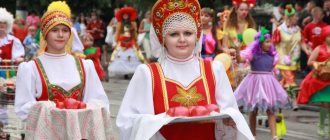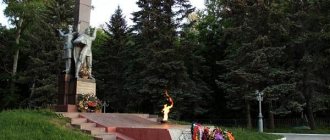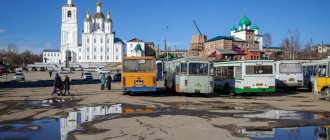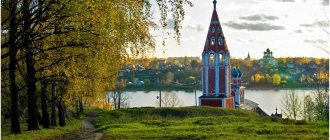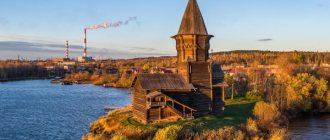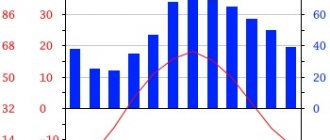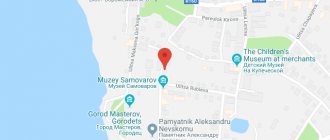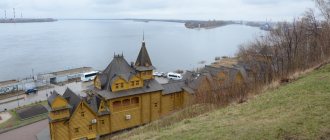Countries > Russia
Vladimir is one of the oldest cities in Russia with a rich history and part of the popular Golden Ring tourist route. He managed to preserve most of the historical heritage, so there are many unique monuments of ancient Russian art and architecture, and on the central streets it is easy to mentally transport yourself back several centuries. What you should visit during your visit and what sights you need to see are in this post.
- Attractions
- Interesting places
- Map
List of places
Bolshaya Moskovskaya Street
Bolshaya Moskovskaya is the main street of Vladimir, where most of the attractions are concentrated. It is amazing that it has retained its 19th-century appearance - which is very rare for Russian cities. Almost every building is a historical and architectural monument. From this street you can judge what the cities of Central Russia looked like two centuries ago, and only modern signs and active traffic remind us of the present.
City Duma
On Bolshaya Moskovskaya, the impressive building of the former City Duma, built in 1907, immediately attracts attention. At the beginning of the 20th century, the pseudo-Russian and “brick” style was popular, and this is one of its successful examples.
Mother of God Nativity Monastery
Also on Bolshaya Moskovskaya there is the ancient Nativity of the Mother of God Monastery, founded by Prince Vsevolod Yuryevich in 1191. It was here that Alexander Nevsky was originally buried, whose relics were then transferred to St. Petersburg. Unfortunately, not much has survived from ancient times from the original buildings, since the monastery has experienced several destructions over its long history. Now the oldest buildings are the former defensive walls.
In the 13th century, the monastery was plundered during the invasion of Batu. In the 19th century, ancient pre-Mongol temples were dismantled. The ancient churches were demolished in the 1930s as part of an anti-church campaign, and the Cheka and a pre-trial detention center were located on the territory of the monastery. In the 1990s, a revival began and the destroyed buildings were rebuilt. Detailed information can be read at the stands; entry to the territory is free.
Dmitrievsky Cathedral
Once upon a time there was a Kremlin in the center of Vladimir, but its walls have not been preserved, so now you enter its territory unnoticed. Inside the Kremlin there was the Demetrius Cathedral, which has survived to this day in a reconstructed, but nevertheless close to its original form. It was built by order of Vsevolod the Big Nest in 1194-1197 and named after the icon of Dmitry of Thessalonica. Over such a long period of existence, the temple lost some parts and elements, but what has survived is a truly unique example of ancient Russian architecture.
The façade is decorated with bas-reliefs of mythical creatures and animals, which are generally typical of medieval architecture, but are very rare in Russia. Based on the subjects of the white stone carvings, one can judge the folklore of that time and see the mixture of pagan and church traditions. Such an amazing contrast is noticeable in the proximity of smiling lions with saints and historical figures.
At the same time, the very structure of the Dmitrievsky Cathedral is traditional for Orthodox churches and, in general, is a striking example of Vladimir-Suzdal architecture. Initially it was built as a house temple for Prince Vsevolod and his family.
If possible, it is worth going inside, as fragments of frescoes from the 12th century have been preserved inside. There is also a small historical exhibition; entrance costs 150 rubles.
How to get to Vladimir?
Everything is very simple here! Dozens of trains and buses run between Moscow and Vladimir daily, but I recommend that you use trains so as not to depend on the situation on the road.
Trains to Vladimir
There are several types of trains departing to Vladimir, including:
- regular electric trains with 6000 numbering. Travel time is 3.5 hours, but you can get discounted travel. The fare is 485 rubles*
- “fast” trains and “branded express”. Travel time—2 hours 40 minutes. Fare—530 rubles*
- Lastochka and Strizh trains are the fastest and most modern trains to Vladimir. Travel time - 1 hour 40 minutes. Travel cost - from 1200 rubles**
* according to the portal tutu.ru.
** according to the portal lastochka-poezd.ru
In fact, you can go for a walk to Vladimir for just 1 day, without stopping overnight. In general, some people living in Moscow take longer to get to work than it does to travel from Moscow to Vladimir by Lastochka and Swift. But, if you can stay overnight, you will have the opportunity to spend a whole unforgettable weekend in the city.
By car from Moscow to Vladimir
By personal transport, the journey to Vladimir is not that long, only 250 km. I wrote about my own experience here - In Vladimir for the weekend | Description of the trip and difficulties along the way
Interesting places
Pedestrian streets
In the area of the Nikolskaya and Spasskaya churches along Geogrievskaya Street, a pedestrian quarter was created with antique-style signs, posters and advertisements. This atmospheric place is great for photography and walking.
There are several interesting points in the quarter: a monument to a fireman, where you can try to pump water yourself, the sculpture “Scientist Cat”, a customs booth and a chapel in honor of the 2000th anniversary of Christianity. Many people visit the Old Pharmacy Museum with historical pharmaceutical exhibits and the Borodins' forge with an interactive exhibition.
Water tower
The historic water tower, which worked for its intended purpose until the mid-20th century, now houses the Old Vladimir Museum. The exhibition is dedicated to the urban life of past centuries: the interiors, clothing, and household items of the townspeople of that time were recreated. On the top floor there is a glass observation deck. Entrance costs 150 rubles.
Patriarchal Garden
Below the water tower is the Patriarchal Garden with a rich collection of plants. It is believed that the garden was founded nine centuries ago. In the spring, orchards bloom and flowers bloom in the garden, but at any other time of the year the park offers picturesque views of the landscaped landscape with fountains, gazebos and a pond.
What kind of entertainment should you plan to get everything done?
Following the route of attractions, you will also have time to unwind a little by visiting several passing places. Below are some of them.
Vladimir Planetarium
You can stop by on the way to the Historical Museum. Here the viewer finds himself in a fascinating cosmic world.
The planetarium is equipped with modern equipment and optics. This will help you learn a lot of interesting facts about our solar system and the universe.
You will also learn to recognize constellations and be able to observe celestial bodies through a telescope. Scientific and entertainment events are often organized here.
Complex "Trading Rows"
On the way from the Gingerbread House to the Spoon Museum, visit the 20th-century Trading Rows complex. Today it is an architectural monument of local importance, with an area of more than 30,000 m².
It includes galleries of more than 50 atmospheric merchant shops with a variety of goods: from food to clothing. There is also a café where you can grab a bite to eat before continuing your city tour.
Ferris wheel "Sky33"
The Sky33 Ferris wheel is a 10-minute drive from the Stoletovs' house. The attraction was launched in 2015 and it immediately became one of the most significant places in the city. The wheel is one of the 10 highest in the country.
By purchasing a ticket for the wheel, you get a 15-minute sightseeing tour of Vladimir from a height of 50 meters. From here you can enjoy a picturesque panorama of the city and its surroundings.
Ticket price up to 200 rubles.
Retro warehouse
Another place worth visiting in Vladimir. The retro warehouse is located 2 minutes from the bus station, so you can visit it either at the very beginning of your city tour, or at the end.
Here you will discover forgotten or little-known exhibits of the 19th and 20th centuries. You can buy your favorite rare items.
Singing fountain
You can complete an unforgettable tour of the historical center of Vladimir with a glass of tea at the Drama Theater. A singing fountain with music and lighting creates a unique atmosphere for vacationers.
House with the ghosts
On Bolshaya Moskovskaya Street in Vladimir there is an unusual building at number 24. Citizens often call it the Governor’s House or the “Haunted House”. Now the Center for Promotion of Fine Arts is located there. The first civil governor, Pyotr Gavrilovich Lazarev, the father of the famous navigator Mikhail Petrovich Lazarev, built the building in 1798. The house housed a hospital and a pharmacy. The next governor placed his home in the building. One of the governors, Ivan Mikhailovich Dolgorukov, was a wonderful musician, poet and artist. He and his family lived in the house from 1802 to 1807. According to one legend, the spirit of the governor’s wife, who died early, appears in the building, for which the house received its strange additional nickname.
Private Museum Gzhel
This museum of painted items turned out to be unique not only on the scale of Vladimir, but also the country and the world. Initially, it was a personal collection of Gzhel, but very soon too many materials accumulated in the collection: from porcelain figurines to chess and pencil cases. Then it was decided to allocate a separate building for her, which became the house of the merchant Vasiliev. The ancient building was ideal for a. Today the museum's exhibition includes more than 1000 exhibits displayed in three halls. Some of the products are exhibited in major museums in the country and the world.
Assumption Cathedral
The most frequently visited sanctuary by guests of the city is the Assumption Cathedral. It was built in the middle of the 12th century, during the era of A. Bogolyubovsky. This beautiful sanctuary, many famous craftsmen were involved in its construction, was built with the aim of preserving the most important spiritual value of the country - the icon of Our Lady of Vladimir, which has been the patroness of Rus' for many centuries. Today this relic is shown to people in one of the Moscow churches, but even after it was moved to another Holy Repository, the Assumption Cathedral is still majestic. Its unique architecture still pleases the eyes of residents and guests of Vladimir. Jewelry, icons and paintings (by Andrei Rublev), which are 600 years old, have also been preserved.
Cathedral Square
The space in front of the iconic churches is organized into Cathedral Square. The atmosphere of the Middle Ages is combined with the flavor of a provincial town of the 18th-19th centuries and the tastes of the Soviet era.
- In the center of the square stands a monument to the 850th anniversary of the city of Vladimir ; it symbolizes three directions of the life of the city: struggle, creativity, labor. A warrior sitting at the monument looks at the Golden Gate; the architect's gaze is focused on the Assumption Cathedral; the worker faces the industrial area of the city. The bronze figures and the entire monument give the impression of heaviness and staticity, especially against the backdrop of the elegant monuments of the 12th century. Maybe that’s why the city residents gave the monument the nickname “Three Lazy People.”
- The image of Andrei Rublev - sophisticated and spiritual - organically fit into the temple ensemble of Cathedral Square. Moscow sculptor O.K. Komov worked on this monument for 20 years; it became the artist’s swan song.
- “Chambers” - a long yellow building in a classical style seems completely out of place between two snow-white cathedrals. Another name for “Chambers” is Public Places. The building was built at the end of the 18th century by decree of Catherine the Second to organize city government. For about 200 years, it was dominated by a bureaucratic spirit, but in 1990, the residents of Vladimir managed to oust officials from the Chambers and organize museum exhibitions in them. On the ground floor, children get acquainted with the “Outpost of the Heroes”, “Land of Toys”, “Fun Fair”. On the second floor, the exhibition “Charm of Bygone Days” recreates the atmosphere of life in ancient noble estates. On the third floor there is an art gallery of paintings by Russian artists: icons of the 13th century, beautiful paintings by Shishkin, Aivazovsky, Vasnetsov.
Chambers. Exhibition “Charm of Bygone Days”
Advice. No matter which direction you approach Vladimir from, start getting to know him on Cathedral Square. Her examination will take 1-3 hours.
Story
The first mention of an ancient Russian settlement located on the Klyazma River was found in the chronicle of 990. But the history of the city of Vladimir itself dates back to 1108. It was during this period that the fortress was built by Prince V. Monomakh. The defensive structure was named in his honor.
The location of the fortress in these places was not chosen by chance. It was protected from the north by the Swan River, and from the south by the steep banks of the Klyazma. Deep ravines prevented anyone from approaching the fortress from the east and west.
The history of the city of Vladimir is inextricably linked with Prince Yuri Dolgoruky (heir to Monomakh). By his order, in 1157 a new courtyard was built in the fortress, in which the Church of St. George the Victorious was erected. After this, the city began its rapid growth.
Prince Andrei Bogolyubsky (son of Yuri Dolgoruky) instead of Kyiv, Vladimir was proclaimed the capital of Rus'. From this period, grandiose construction began in the city, during which new ramparts with wooden walls and passage gates were erected, and the defensive ring was expanded.
The year 1238 came. The Tatars attacked Vladimir. They plundered and burned the city. He could no longer rise to his former greatness. The destroyed buildings were rebuilt very slowly.
At the end of the 13th century. It was decided to move the residence of the Russian metropolitans from devastated Kyiv to Vladimir. For some time, the city became the center of the northeastern regions of Rus', where congresses of princes were held and the all-Russian chronicle was kept.
In the 14th century the episcopal and grand princely thrones were transferred from Vladimir to Moscow. The city became ordinary, leaving behind memories of its former greatness, as well as rebuilt shrines.
During the 14th-17th centuries. Raids on Vladimir, robberies, and fires did not stop. That is why in the 17th century. Large-scale construction of stone structures began. By 1668, about four hundred houses had been built in Vladimir, in which nine hundred and ninety people lived.
In 1796, the status of the city changed. It became the center of the Vladimir province. And construction has resumed here again. During this period, the bell tower of the Assumption Cathedral, the governor's house, the guest rows, the Assembly of the Nobility, and other buildings were built in Vladimir. In 1861, a railway first appeared in the city.
A little about the city
Vladimir could currently be the capital of Russia, because it was founded before Moscow, and the formation of the state began with it in the 11th-12th centuries. There are 2 versions of the emergence of Vladimir. According to one, it arose thanks to the baptist of Rus', Vladimir Svyatoslavovich, who erected a fortress on the banks of the Vyazma River in 990. According to another, the city was founded by Vladimir Monomakh in 1108.
From the beginning of the 12th century, Vladimir was the center of North-Eastern Rus' and the capital of the Rostov-Suzdal principality. In 1157 it became the capital of Rus', and remained so until 1439.
After numerous plunders of the city by the Tatar-Mongols, Vladimir began to submit to the Moscow princes and gradually became a provincial town. In the 20th century (1944) it became the administrative center of the Vladimir region, and in the 21st century it became part of the Central Federal District.
According to the State Statistics Service 2017-2018, over the 5 years from 2012 to 2022, the population of Vladimir grew from 345,907 to 356,138 people. Up to 82% of the city's population are Orthodox Christians, the remaining 18% are Catholics, Muslims, and Baptists. About 97.5% of the population is Russian, and 3% are Ukrainians, Belarusians, Armenians, Tatars and other nationalities.
Vladimir map
Vladimir is located just 176 km from Moscow in a temperate climate zone. It snows for almost 4 months in the city and rains for 4.5 months, but in total there is not much precipitation - only 58.4 cm per year. There are clear, cloudless days in Vladimir for only 4 months. Average summer temperatures are 17°C, winter temperatures are only -8°C, although they can reach +37 and -43°C.
More than half of the territory of the Vladimir region is occupied by mixed forests, in which, in addition to the frequently occurring birches, pines and spruces, you can see:
- Siberian larch;
- oak trees;
- hazel;
- viburnum;
- rowan
The natural relief includes both hills not covered with forests and swampy lowlands.
Places in the area are rich in berries such as blueberries, lingonberries, raspberries and various mushrooms. And in the swamps you can find cloudberries, blueberries, and cranberries. Many of the 1,400 plants and 230 species of mosses found in the region are listed in the Red Book. The fauna is quite diverse.
Among the mammals in the nearby forests of Vladimir you can find:
- deer;
- moose;
- wolf;
- fox;
- bear;
- bison and others.
More than 200 species of birds live in the vicinity of the city: partridges, capercaillie geese and many others. Among the fish in lakes and rivers, not only crucian carp, perch, pike perch, pike and catfish are caught, but also sterlets. Some species of fauna are listed in the Red Book: brown bear, bison, muskrat, sterlet.
Who should go
Anyone who wants to learn more about the history of Russia and Rus', be inspired by stunning ancient monuments and feel the amazing spirit of holiness that surrounds the city's numerous churches and cathedrals.
Among them are the Assumption and Demetrius Cathedrals, recognized by UNESCO as world cultural heritage sites, as well as the famous Golden Gate, which has no analogues either in Russia or in the world.
It’s worth coming to this city for a couple of days to take a break from the noise and dust of the metropolis, immerse yourself in the quiet contemplation of the luxurious local nature, and touch sacred places. Both adults and children will enjoy the trip, because there are enough entertainments for children here, which will also be useful for broadening their horizons.
wikipedia.org / Vladimir-city / CC BY-SA 3.0
Where to stay for a short time?
The main places of Vladimir are in the central part. Therefore, in order to have time to visit all the sights of the city, you should live in close proximity to them.
The best solution is to rent a room at Sokroma hotels in the historical center of Vladimir. Sokroma offers guests three hotels within walking distance from significant tourist locations. Each of them is equipped for the convenience of guests' stay.
Boutique Hotel on Nikolskaya
– 17 rooms, each of which has: WiFi, LCD TV, refrigerator, kettle, hairdryer, wardrobe, etc. Pets are allowed.
It is located 7-10 minutes from the Assumption Cathedral, the Chamber of Representatives Museum, the House of Spice, etc. From the hotel to the main place of the city, the Golden Gate - 200 m.
Apartments "Vladimirskaya Rus"
– full-fledged apartments with a sleeping area, equipped kitchen and bathroom.
There is parking and a children's playground in the yard. McDonald's, KFC, cafes and restaurants are within walking distance.
Apartments "Historical Vladimir"
with all the amenities, high-quality repairs and homely furnishings. The territory is fenced. It's a 3-5 minute walk to Cathedral Square and the Golden Gate.
There are many restaurants and cafes nearby (including children's). Convenient location for traveling anywhere in Vladimir by car or public transport.
VladimirGagarin Street, 8 — Yandex.Maps
